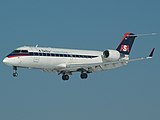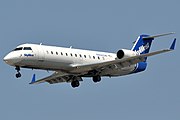Talk:Bombardier CRJ100/200/Archive 1
| This is an archive of past discussions about Bombardier CRJ100. Do not edit the contents of this page. If you wish to start a new discussion or revive an old one, please do so on the current talk page. |
| Archive 1 |
CRJ200
Looking at the FAA and Canadian type certificates under the official name of CL-600-2B19 only the two marketing names are listed, the Regional Jet Series 100 and Regional Jet Series 440. The article states that the 200 is a 100 with 3B1 variant engines. Both type certificates state that the 100 series can be fitted with either CF-34-3A1 or 3B1 engines. Just for information. MilborneOne 18:58, 9 November 2007 (UTC)
End of production?
I've seen some commentary in other articles (Bombardier's page, I think, and maybe Dash 8) that the CRJ200 is (going) out of production, with commetns on why, and that the Dash 8/Q Series is now preferred over the 200. Does anyone have any sources that back this up? If true, some of it needs to be here, especially the parts of the smaller CRJs going out of production. - BillCJ 18:20, 4 December 2007 (UTC)
I think the CRJ100/200 compete internally with the Dash8-Q400. In the 90's, people were afraid of turboprops because of safety, plus they were loud. RJ's took over the 40-50 seat market because they were faster and more comfortable. Lately, with fuel prices on the rise, turboprops are coming back. —Preceding unsigned comment added by Mgw89 (talk • contribs) 01:02, 4 January 2008 (UTC)
Cold weather operations
For the past few days Air Canada Jazz has cancelled flights to and from Yellowknife because "their CRJs are not certified for operations below -40". It seems strange that a Canadian-designed airplane wouldn't be certified for cold-weather operations, while their competitors (in the north) who operate Boeings haven't missed a flight because of the cold. Does anyone know anything about the CRJ cold-weather certification?
Charles Dent 216.108.187.98 (talk) 03:32, 31 January 2008 (UTC) 216.108.187.98 (talk) 03:32, 31 January 2008 (UTC)
CRJ 100 vs 200
Reading this entry, it is clear they marketed two different models. However, the entry is not clear on the differentiation between the models and the timeline for each of them. IE: the CRJ200 was sold from x year onwards and improved on the CRJ100 in this manner. Yes it says that the engines differ later on in the piece, but to the lay person the engine specs read the same, and everything else reads the same. Surely there are more differences between the two than just a letter in the engine model? —Preceding unsigned comment added by 203.59.201.219 (talk) 14:13, 14 February 2008 (UTC)
With regard to the engines, they ARE different. They have differences in their "hot section" (the highest temeprature part of the engine) which results in differences in their maintenance requirements. Also, the -3B1 engines can as a result be run "hotter", so they are flat-rated to a higher temperature than the -3A1 - so they have the same thrust on a cold day, but the -3B1 has more thrust than a 3A1 on a hot day. Note 14 to the Type Certificate data Sheet for the CF34 - available through the FAA website: http://rgl.faa.gov/Regulatory_and_Guidance_Library/rgMakeModel.nsf/0/2a86c17d7da250ef86256fd900674745/$FILE/E15NE.pdf - illustrates this.
Regarding the CRJ100 vs CRJ200 timescale, there is no simple cut-in, either in terms of calendar date or manufacturer's serial number. MadScot666 (talk) 23:27, 2 August 2008 (UTC)
Editing Suggestions - COI
As mentioned elsewhere, I have a COI regarding this article, being an employee of the designing company, so I'll put some editing suggestions here on the Talk page:
Development
"The aircraft was based on the Canadair Challenger design, which was purchased by Canadair from Learjet in 1976.". That last part is untrue. While Bill Lear was involved at the conceptual design stage of the Challenger 600 (as described correctly on Bombardier Challenger 600, he did so in a personal capacity, as he had resigned from LearJet by then. To avoid duplication, I suggest that the text simply become:
- The aircraft was based on the Canadair Challenger design.
"The first of three development machines for the initial CRJ100 performed its first flight on 10 May 1991, though one of the prototypes was lost in a spin mishap in July 1993, The type obtained certification in late 1992, with initial delivery to customers late in that year." While the section highlighted is true, it isn't releveant in the context, as the loss of 7001 in 1993 did not impact initial certification and delivery. I would suggest that the accident be referenced in the list of accidents (from where it is currently omitted) and the sentence become:
- The first of three development machines for the initial CRJ100 performed its first flight on 10 May 1991, and the type obtained certification in late 1992, with initial delivery to customers late in that year.
Under CRJ100 Suggest the statement "two more emergency exit doors" in the first sentence be changed to "two overwing emergency exit doors" since otherwise the impression may be obtained that additional standard-type doors were fitted. The sentence "Typical seating was 50 passengers, the maximum load being 52 passengers." is incorrect. Refer to the [TCDS] - under 'Maximum Occupants' on page 16. The maximum passenger capacity is 50, not 52. I think someone has confused the flight attendant seats with passenger seats. Suggest reword to:
- Standard seating was 50 passengers.
Variants
Since this section addresses only variants of the CL-6--2B19, the seating capacity is incorrectly described as "ranging in capacity from 40 to 86 passengers". Since there are actually some variants which are restricted below that range, and none above 50, suggest it be reworded to state:
- Several models of the CRJ have been produced, ranging in capacity up to 50 passengers.
The use of Challenger 800 is anomalous; I don't believe I've ever heard the corporate/business version described as an "800". Early aircraft of this type were variously described as "Canadair Special Editions" or "CRJ-SE". Use of Challenger 850 is relatively recent. Suggest it be renamed
Incidents and Accidents
As suggested above, add the 7001 accident here:
- On July 26, 1993, aircraft number 7001 (the first prototype aircraft) crashed during a test flight out of Wichita, Kansas. The aircraft stalled during a sideslip manoeuvre and control of the aircraft was never regained. All three crewmembers onboard were killed.
Additionally, the following accident is omitted [Air Safety network report]:
- On February 13, 2007, a corporately configured CRJ-SE crashed on takeoff from [Vnukovo International Airport], near Moscow. The aircraft was on a positioning flight and the three crew onboard survived the accident.
MadScot (talk) 14:05, 20 September 2008 (UTC)
Infobox comment
Additional item - the upper price listed in the infobox isn't right ($39m). That sounds like a CRJ-900 price (even then, it's high) rather than a CRJ100/200 price to me. MadScot (talk) 00:29, 10 October 2008 (UTC)
Similar Aircraft
What are the criteria to be used? I note a number of larger RJ type aircraft have been added - typically 70-100 seaters - and really the CRJ-100/200 should only be compared to the smaller RJs, such as the ERJ-135/145 family. The 70-100 seaters form a different class of aircraft - in many cases, mainline airline scope clauses come into effect for these aircraft - and I'd suggest trimming the list of similar aircraft to nreflect this —Preceding unsigned comment added by MadScot (talk • contribs) 17:41, 14 December 2008 (UTC)
Infobox image
Perhaps we should change the infobox image to a flying shot like the Cimber Air one or similar? MilborneOne (talk) 21:09, 31 August 2013 (UTC)

main picture
-
current
-
proposed
The current image is fine, but its livery hides the cabin windows. The proposed replacement shows them, and better shows the wing also.--Marc Lacoste (talk) 06:45, 24 November 2018 (UTC)
Mitsubishi sale?
I recently tagged an ambiguous reference to MHI in this article which another user subsequently removed; I presume that it referred to Mitsubishi Heavy Industries but I cannot be sure because the sentence was vague. My question: Was the CRJ100/200 product line sold to Mitsubishi Heavy Industries along with the CRJ700/900/1000 series? Neither Wikipedia article states whether they share type certificate(s) and a quick browse of online news sources has not been enlightening; all of them seem to talk about the CRJ700/900/1000 series exclusively. Carguychris (talk) 15:02, 5 January 2021 (UTC)
- Found good sources, will post improved explanation momentarily. Carguychris (talk) 18:44, 5 January 2021 (UTC)
- Reviving this discussion since some of my edits have been reverted I didn't realize that Mitsu vs. Bombardier naming issue has been a point of contention on the other CRJ pages. I agree that the Mitsubishi sale is largely inconsequential in terms of overall CRJ100/200 history, but whether or not the aircraft has been technically renamed as a Mitsubishi, I still think there should be a quick mention in the lead since many online sources and tracking apps like Flightradar24 now refer to the aircraft as a Mitsubishi. My concern is that some readers will not read past the lead and will continue fruitlessly searching for info about another nonexistent aircraft produced as the Mitsubishi CRJ200. Carguychris (talk) 18:02, 6 January 2021 (UTC)
- I see no objection to mentioning the sale of the program, maybe even briefly in the lead, but the supposed renaming of the aircraft has indeed been a point of contention. I'm pretty sure that the Business Insider reference you added has got things wrong, in that Mitsubishi itself does not refer to the CRJ under the Mitsubishi name; admittedly some third parties such as flightradar have relabelled the aircraft, but I have yet to see any confirmation of an official rename. Rosbif73 (talk) 19:49, 6 January 2021 (UTC)
- I second Rosbif73.--Marc Lacoste (talk) 21:26, 6 January 2021 (UTC)
- New version posted. Carguychris (talk) 22:14, 6 January 2021 (UTC)
- I second Rosbif73.--Marc Lacoste (talk) 21:26, 6 January 2021 (UTC)
- I see no objection to mentioning the sale of the program, maybe even briefly in the lead, but the supposed renaming of the aircraft has indeed been a point of contention. I'm pretty sure that the Business Insider reference you added has got things wrong, in that Mitsubishi itself does not refer to the CRJ under the Mitsubishi name; admittedly some third parties such as flightradar have relabelled the aircraft, but I have yet to see any confirmation of an official rename. Rosbif73 (talk) 19:49, 6 January 2021 (UTC)
- Reviving this discussion since some of my edits have been reverted I didn't realize that Mitsu vs. Bombardier naming issue has been a point of contention on the other CRJ pages. I agree that the Mitsubishi sale is largely inconsequential in terms of overall CRJ100/200 history, but whether or not the aircraft has been technically renamed as a Mitsubishi, I still think there should be a quick mention in the lead since many online sources and tracking apps like Flightradar24 now refer to the aircraft as a Mitsubishi. My concern is that some readers will not read past the lead and will continue fruitlessly searching for info about another nonexistent aircraft produced as the Mitsubishi CRJ200. Carguychris (talk) 18:02, 6 January 2021 (UTC)


